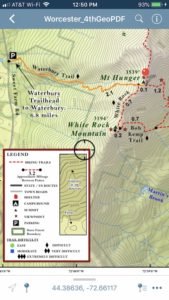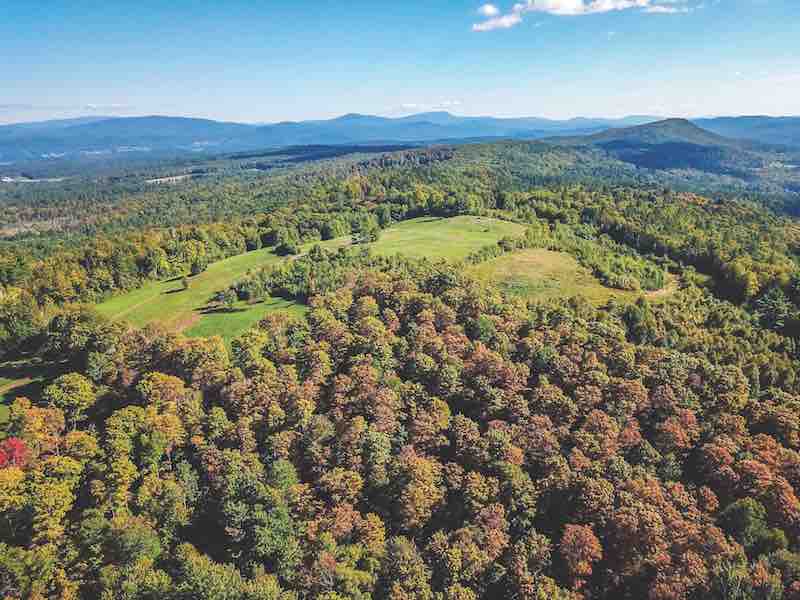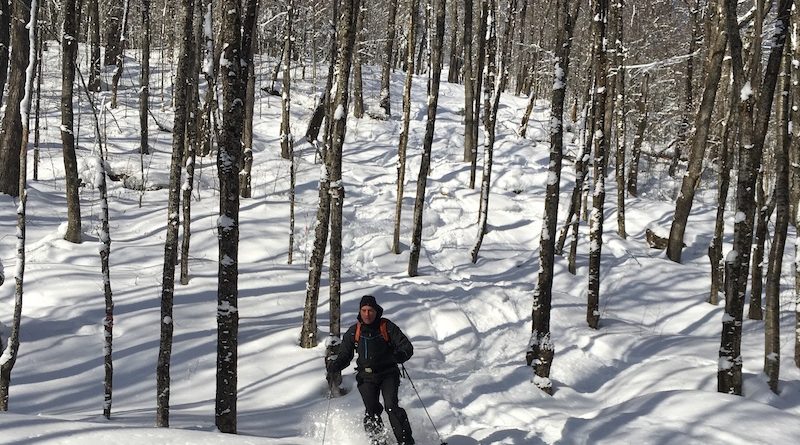Vermont’s Backcountry Blitz
New Backcountry Ski Routes, Chapters and Huts
The Northeast Kingdom Backcountry Coalition, a chapter affiliate of the Catamount Trail Association, has announced the fruits of its two-year collaboration with the Vermont Department of Forest, Parks and Recreation to expand backcountry ski trails in Willoughby State Forest. On December 17, NEKBC announced that new ski lines have been added on

Bartlett Mountain and to Moose Haven in the East Haven Zone.
Over the next several years, the agency and nonprofit will enhance and add to an existing 12-kilometer network of groomed cross-country ski and snowshoe trails in the state forest. The project, similar to the Brandon Gap glades which were built on National Forest Land, is the first of its kind to provide access and manage vegetation for backcountry skiing and snow sports on state lands.
NEKBC began working with VFP&R in fall 2016 to design winter backcountry recreation opportunities in the Willoughby State Forest. The plan includes proposed ski lines on Mount Hor, Bartlett Mountain and off of the CCC Road. It also includes a network of uphill skin tracks to connect the improved lines with a parking lot on Route 5A and existing trails.
Also new for this winter, the Vermont Huts Association announced a new backcountry hut in Huntington, Vt., located on privately owned land off of Camels Hump Road. The new cabin—which is insulated, has a woodstove and sleeps four—is located just off the Catamount Trail and is expected to open for reservations in early 2019. Plus, the organization opened Chittenden Brook Hut, located near Rochester, Vt., in December and has plans to rebuild the South Pond Cabin, which burned down in an arson fire in January 2018, in Chittenden, Vermont this spring.
On December 7, the Mad River Valley Backcountry Coalition hosted its launch party. The new group of backcountry users and advocates is a chapter of the Catamount Trail Association and will focus on enhancing opportunities for wintertime backcountry recreation in the Mad River Valley. Though the group has yet to announce projects, its bylaws state that it will “assist where requested or appropriate, through information gathering, education and public service, in the management of glades and trails.”
The Long Trail Goes Digital
Here’s a good new use of technology: as of December 2018, hikers in the Green Mountains can now navigate and track their adventures using their smartphones.
The new service is part of the Green Mountain Club’s brand-new digital map service. It allows users to purchase and download maps directly to their smartphone. Once downloaded, the information is available even when cell service is not because it relies on

GPS technology, meaning users can take photos, mark waypoints and track their progress on a trail.
So far, 12 of the state’s most popular hiking areas are available for download and purchase at avenzamaps.com. Matt Krebs, operations/publications coordinator for the GMC says the organization hopes to have the entire Long Trail available digitally in time for hiking season in spring 2019.
“This new program helps the GMC as well as hikers. We’re hoping that volunteers will go out and gather data for us and report things like blow-downs or needed trail maintenance using the app’s GPS waypoint storage system,” says Krebs. Essentially, a hiker could now go out on a trail, see a problem, mark its GPS coordinates, return home and upload or send that information to Krebs who could then disperse it to the Green Mountain Club’s network of volunteers and trail stewards.
However, Krebs doesn’t expect the apps will eliminate the need for paper maps. “Paper maps should still be thought of as a requirement when you’re in the backcountry,” said Krebs. “They don’t have batteries that die and give you a much broader visual of where you are than a phone screen.”
Tucker Mountain Preserved as Town Forest
On December 13, the Town of Newbury, Vt. made sure that 636 acres of iconic farm and forestland will be preserved and open to the public as a new town forest.
Located in the Upper Valley, the new Tucker Mountain Town Forest includes most of the 1,690-foot Tucker Mountain, along with the town’s highest point, Woodchuck Mountain, at 1,742 feet.
The property was purchased in the early 1970s by Phil and Ginny Leach with the mission of protecting its high pastures and woodlands as open space. When the Leaches died, their family decided to sell to the Vermont Land Trust for just $384,500, about half its appraised value.

On December 13, 2018, the Newbury Selectboard voted to contribute $25,000 toward the purchase of the town forest. The project was also funded by grants from the Vermont Housing and Conservation Board, the Open Space Institute’s Community Forest Fund, the Upper Connecticut River Mitigation and Enhancement Fund of the New Hampshire Charitable Foundation, the National Fish and Wildlife Foundation, Fields Pond Foundation and charitable donations from the community.
Additionally, more than 115 donors from the Upper Valley contributed close to $100,000 to complete the purchase and endow a dedicated stewardship fund for the property. A stewardship and management plan is in the works. The property offers 360-degree views from its pasture summit and has since the fields were first cleared in 1810. Under the Leaches’ ownership it was frequented by hunters, hikers, cross-country skiers, snowmobilers, mountain bikers, horseback riders and ATV riders.
An opening celebration will be held this spring and until then, visitors should go to newburyconservation.org to learn about access to the property and permitted uses.
Can Talent Skatepark Make a Comeback?
When South Burlington’s legendary Talent Skatepark and Shop closed its doors this past August, skaterboarders across the Champlain Valley and beyond mourned.
The shop, founded by Hannah Deene Wood in 2001, launched young pro skaters such as Chris “Cookie” Colburn, Jordan Maxham and Collin Hale over its 17 year tenure as a South Burlington institution. Deene, who owned and operated the business with her husband Dave Wood, offered lessons, camps and clinics to cultivate the next generation of young skateboarders, longboarders and inline skaters. It also provided a place for kids to roam free and get indoor exercise year-round over its 8,300 square feet of terrain.
For one group of parents, that service was invaluable. When Talent shut its doors this past August, citing lower rates of participation and sales at its shop, the parents teamed up with former owner Deene with the goal of reopening the skate park as a nonprofit. “We weren’t done working with our community,” said Deene in early December. “But the world changed and the convenience of online shopping pulled away loyal customers. Regardless, there is still a huge population of skateboarders who need a place to hone their skills, as well as a safe haven that they can consider a second home.”
Deene, who suffered a traumatic brain injury in 2001, just before opening Talent Skate Park, is a huge advocate for helmet use. She’s been a keynote speaker at the Vermont Brain Injury Conference, hosted by the University of Vermont.
Though the skatepark won’t reopen this winter, the group is hosting its first fundraiser called the Talent Family Reunion at Arts Riot in Burlington. The music of local bands will be featured, including Rough Frances and stand-up comic Richard Bowen. For more information or to donate to the cause, visit gofundme.com/talentskatepark

